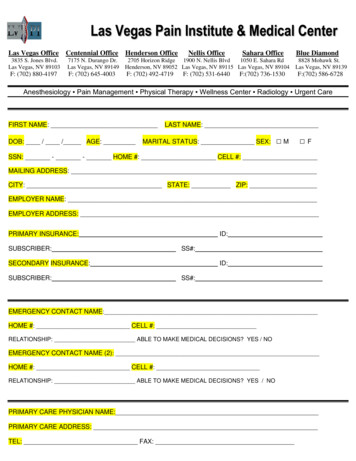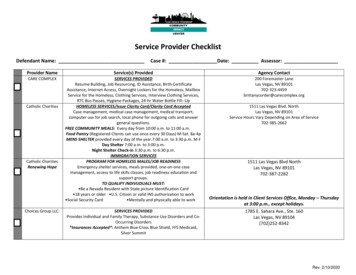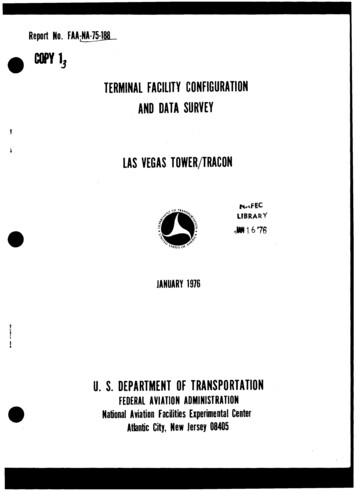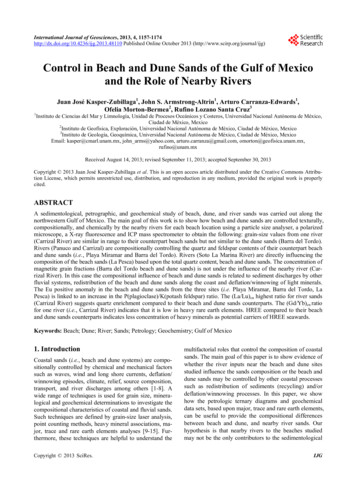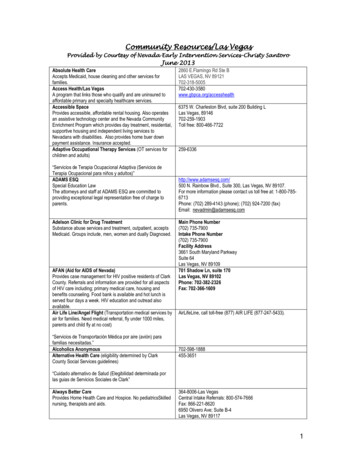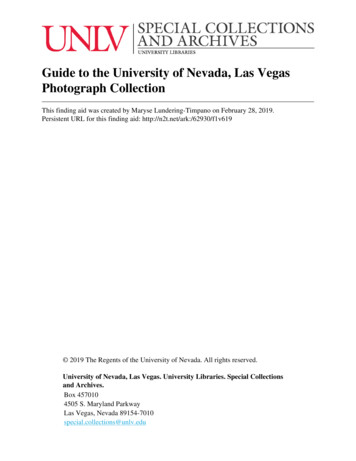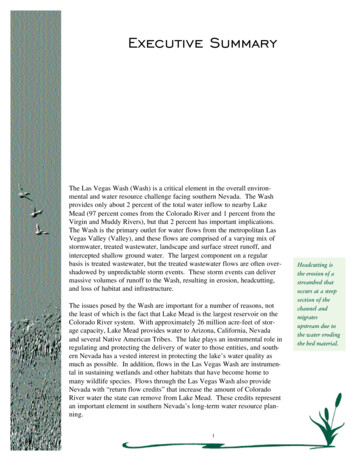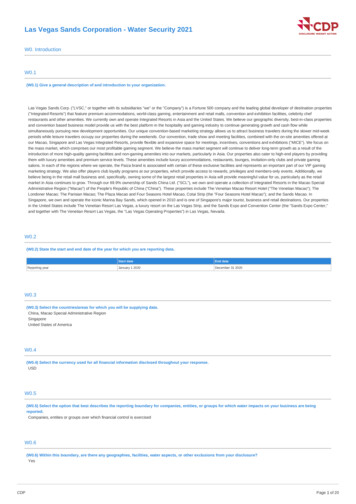
Transcription
Las Vegas Sands Corporation - Water Security 2021W0. IntroductionW0.1(W0.1) Give a general description of and introduction to your organization.Las Vegas Sands Corp. ("LVSC," or together with its subsidiaries "we" or the "Company") is a Fortune 500 company and the leading global developer of destination properties("Integrated Resorts") that feature premium accommodations, world-class gaming, entertainment and retail malls, convention and exhibition facilities, celebrity chefrestaurants and other amenities. We currently own and operate Integrated Resorts in Asia and the United States. We believe our geographic diversity, best-in-class propertiesand convention based business model provide us with the best platform in the hospitality and gaming industry to continue generating growth and cash flow whilesimultaneously pursuing new development opportunities. Our unique convention-based marketing strategy allows us to attract business travelers during the slower mid-weekperiods while leisure travelers occupy our properties during the weekends. Our convention, trade show and meeting facilities, combined with the on-site amenities offered atour Macao, Singapore and Las Vegas Integrated Resorts, provide flexible and expansive space for meetings, incentives, conventions and exhibitions ("MICE"). We focus onthe mass market, which comprises our most profitable gaming segment. We believe the mass market segment will continue to deliver long-term growth as a result of theintroduction of more high-quality gaming facilities and non-gaming amenities into our markets, particularly in Asia. Our properties also cater to high-end players by providingthem with luxury amenities and premium service levels. These amenities include luxury accommodations, restaurants, lounges, invitation-only clubs and private gamingsalons. In each of the regions where we operate, the Paiza brand is associated with certain of these exclusive facilities and represents an important part of our VIP gamingmarketing strategy. We also offer players club loyalty programs at our properties, which provide access to rewards, privileges and members-only events. Additionally, webelieve being in the retail mall business and, specifically, owning some of the largest retail properties in Asia will provide meaningful value for us, particularly as the retailmarket in Asia continues to grow. Through our 69.9% ownership of Sands China Ltd. ("SCL"), we own and operate a collection of Integrated Resorts in the Macao SpecialAdministrative Region ("Macao") of the People's Republic of China ("China"). These properties include The Venetian Macao Resort Hotel ("The Venetian Macao"); TheLondoner Macao; The Parisian Macao; The Plaza Macao and Four Seasons Hotel Macao, Cotai Strip (the "Four Seasons Hotel Macao"); and the Sands Macao. InSingapore, we own and operate the iconic Marina Bay Sands, which opened in 2010 and is one of Singapore's major tourist, business and retail destinations. Our propertiesin the United States include The Venetian Resort Las Vegas, a luxury resort on the Las Vegas Strip, and the Sands Expo and Convention Center (the "Sands Expo Center,"and together with The Venetian Resort Las Vegas, the "Las Vegas Operating Properties") in Las Vegas, Nevada.W0.2(W0.2) State the start and end date of the year for which you are reporting data.Reporting yearStart dateEnd dateJanuary 1 2020December 31 2020W0.3(W0.3) Select the countries/areas for which you will be supplying data.China, Macao Special Administrative RegionSingaporeUnited States of AmericaW0.4(W0.4) Select the currency used for all financial information disclosed throughout your response.USDW0.5(W0.5) Select the option that best describes the reporting boundary for companies, entities, or groups for which water impacts on your business are beingreported.Companies, entities or groups over which financial control is exercisedW0.6(W0.6) Within this boundary, are there any geographies, facilities, water aspects, or other exclusions from your disclosure?YesCDPPage 1 of 20
W0.6a(W0.6a) Please report the exclusions.ExclusionPlease explainWe have excluded waterconsumption from ourCotai Water Jet ferryservice.Our Cotai Water Jet ferry service operations are excluded because their water withdrawal is very limited in scope. The operation’s primary consumption of water is through the use ofrestrooms. Data for Cotai Water Jet is difficult to collect and the impacts are believed to be insignificant. We estimate that the volume of water consumption from Cotai Water Jetrepresents less then 0.5% of total water withdrawal or consumption. We nonetheless continue to monitor these operations as necessary for potential water risks and impacts.W1. Current stateW1.1(W1.1) Rate the importance (current and future) of water quality and water quantity to the success of your business.Direct use IndirectPlease explainimportance useratingimportanceratingSufficient Vitalamountsof goodqualityfreshwateravailablefor useImportantOur primary use of freshwater in direct operations is to provide LVS Integrated Resort services. More specifically, freshwater is used for cooking, drinking water, drycleaning/laundry services, air conditioning, restrooms, and for showering. These services are vital to operating all Integrated Resort operations from hotel operations to foodand beverage. Our primary use of freshwater in indirect operations is through our supply chain. Agricultural and linen cleaning suppliers use freshwater to provide us with foodand cleaning services. These products and services are important to running Integrated Resort operations such as operating restaurants and providing clean linen for hotelsuites. We do not anticipate freshwater dependency to change in direct or indirect operations in the future, as our business model remains the same. We will however continueto increase water efficiency and diversify water supply in our resorts. For example, our ongoing well reconstruction project is expected to reduce our municipal water use in LasVegas by approximately 20% once fully implemented. At The Parisian Macao, we built our infrastructure to use greywater from the municipality once available. Similarly, weanticipate the dependency on freshwater supply in indirect operations to remain static. Suppliers will continue to adopt new water strategies and technologies as waterbecomes scarcer. For example, our Sands China Ltd. linen supplier has an Environmental Code, which requires all facilities to recycle water and develop water ,brackishand/orproducedwateravailablefor useImportantIn our direct operations, our primary use of recycled, brackish, and/or produced water is through the purchase of reclaimed water and the use of condensate water at MarinaBay Sands for irrigation, toilet flushing systems, exterior ponds, and some water features. Access to recycled water is important to our business as it reduces our dependenceon scarce freshwater. In indirect operations, our primary use of recycled, brackish, and/or produced water is through our supply chain by various suppliers. It is important thatour linen, agricultural, and other suppliers have access to recycled, brackish, and/or produced water, along with adequate infrastructure and practices, in order to continuouslyprovide us with food and linen cleaning services that are necessary to run our operations. For example, our Sands China Ltd. linen-cleaning supplier has an EnvironmentalCode, which requires recycling of clean wastewater streams from cooling water and boiling systems. Maintaining this greywater system is important to their operations. We donot anticipate dependency on recycled, brackish, or produced water to change in direct or indirect operations in the future as our business model remains the same andfurther, this water source is substitutable with freshwater.ImportantW1.2CDPPage 2 of 20
(W1.2) Across all your operations, what proportion of the following water aspects are regularly measured and monitored?% ofPlease explainsites/facilities/operationsWater withdrawals –total volumes100%Total volumes of water withdrawals are reported monthly by property sustainability teams through a centralized online platform, and analyzed by the GlobalSustainability Department. Water data is taken from utility bills monthly for municipal water, or sub-metered data for rainwater capture, condensate recovery, wellwater withdrawal, and nano-filtration water withdrawal. Total volumes of water withdrawals are monitored through analysis of month over month and year overyear trends. Reasons for changes in withdrawals are then identified by property sustainability teams. For example, we analyze the effects of warmer weather oncooling towers, changes in occupied room nights on use of showers and restrooms, and changes in restaurant covers on water use in back of house areas.Water withdrawals –volumes by source100%Total volumes of water withdrawals by source are reported monthly by property sustainability teams through a centralized online platform, and analyzed by theGlobal Sustainability Department. Water data is taken from utility bills for municipal water, or sub-metered data for rain water capture, condensate recovery, wellwater withdrawal, and nano-filtration water withdrawal and is both region (Singapore, Macao, and Las Vegas) and source specific. Sources include third party(municipal), renewable ground water (well and nano-filtration) and fresh water (rain water and condensate recovery). Reasons for changes in withdrawals bysource are then identified by property sustainability teams. For example, we look at how operational changes such as our well reconstruction, and an increase innano-filtration system capacity at The Venetian Resort impacts our water withdrawal volumes by source.Entrained water Not Applicable associated with yourmetals & miningsector activities - totalvolumes [only metalsand mining sector] Not Applicable Produced water Not Applicable associated with youroil & gas sectoractivities - totalvolumes [only oil andgas sector] Not Applicable Water withdrawalsquality100%Relevant water withdrawals are monitored for quality in accordance with building code and all applicable regulations on a daily or monthly basis as needed. Wealso have our own internal water quality monitoring systems such as ECOLab at a majority of our properties that serve as an additional quality test of potablewater in addition to testing by local water authorities. These tests happen continuously and are monitored on a daily basis in order to ensure that our waterexceeds standard requirements and to protect our guests and workers. Further, we routinely test (daily, weekly, monthly, as needed) our pools and spas againstvarious water quality parameters such as microbial properties. Water that is withdrawn from the municipality, well and nano-filtration system for usage in ourcooling towers is routinely tested for conductivity, a measure of suitability for its use.Water discharges –total volumes100%At properties where water discharge to municipal sources is billed by direct discharge quantity, total discharge volumes are tracked monthly using dischargesubmeters. At properties where water discharge to municipal sources is billed as an estimate of consumption rather than direct discharge, LVS has developed acompany-specific water discharge modeling tool with the help of a third party consultant to estimate total discharge volumes and evaluate the fate of our effluent,segregating our discharge by destination, and estimating our total discharge as an organization. The model is updated as needed with chiller plant efficiency,interior and exterior Grand Canal information, sub-metered data such as lagoon water, irrigation efficiency, and geographic specific evaporation, temperature andhumidity rates.Water discharges –volumes bydestination100%At properties where water discharge to municipal sources is billed by direct discharge quantity, total discharge volumes are tracked monthly using dischargesubmeters. At properties where water discharge to municipal sources is billed as an estimate of consumption rather than direct discharge, LVS has developed acompany-specific water discharge modeling tool with the help of a third party consultant to estimate total discharge volumes and evaluate the fate of our effluent,segregating our discharge by destination, and estimating our total discharge as an organization annually. The model is updated annually with chiller plantefficiency, interior and exterior Grand Canal information, sub-metered data such as lagoon water, irrigation efficiency, and geographic specific evaporation,temperature and humidity rates.Water discharges –Not relevantvolumes by treatmentmethodMonitoring of water discharges volumes by treatment method is not relevant to Las Vegas Sands because all water discharges are sent to, and managed(including testing and treatment) by municipal waste water treatment plants. As this will be the process for water discharges in future years, we do not expectmonitoring of this to become relevant in the future. Further, all of our properties comply with applicable environmental laws related to discharge requirements. Forexample, the City of Las Vegas requires ‘Class I’ facilities to analyze their wastewater pre-discharge, while ‘Class II’ facilities must only comply with applicabledischarge regulations. As a Class II facility, we comply with all discharge regulations around water quality. The frequency of monitoring is up to the discretion ofthe municipalities. We are informed immediately if there are any abnormal water quality issues with discharge.Water dischargeNot relevantquality – by standardeffluent parametersMonitoring of water discharges quality by standard effluent parameters is not relevant to Las Vegas Sands because all water discharges are sent to, managed(including all relevant effluent parameters) by municipal waste water treatment plants. As this will be the process for water discharges in future years, we do notexpect monitoring of this to become relevant in the future. All of our properties comply with applicable environmental laws related to discharge requirements. Forexample, the City of Las Vegas requires ‘Class I’ facilities to analyze their wastewater pre-discharge, while ‘Class II’ facilities must only comply with applicabledischarge regulations. As a Class II facility, we comply with all discharge regulations around water quality. The frequency of monitoring is up to the discretion ofthe municipalities. We are informed immediately if there are any abnormal water quality issues with discharge.Water dischargeNot relevantquality – temperatureMonitoring of water discharge quality including temperature is not relevant to Las Vegas Sands because all water discharges are sent to, and managed (includingtemperature testing) by municipal waste water treatment plants. Further, as we do not discharge directly into open water bodies, tracking water discharge bytemperature is unnecessary for our company operations. As this will be the process for water discharges in future years, we do not expect monitoring of this tobecome relevant in the future. All of our properties comply with applicable environmental laws related to discharge requirements For example, the City of LasVegas requires ‘Class I’ facilities to analyze their wastewater pre-discharge, while ‘Class II’ facilities must only comply with applicable discharge regulations. As aClass II facility in Las Vegas, we comply with all discharge regulations around water quality, however we are not required to track temperature.Water consumption – 100%total volumeThrough detailed monthly water withdrawal reporting, monitoring, and auditing, and our company specific water discharge model, we are able to calculate totalwater consumption. We estimate global water consumption across all of our operations to be approximately 15-20% of total withdrawal. Water consumption iscalculated annually using our internal water model developed with the help of a third party consultant and CDP’s recommended approach of Consumption Withdrawal – Discharge. The model considers various parameters including sub-metered water use by our chiller plants, evaporation rates of exterior waterbodies using regional humidity rates, and estimated loss to groundwater through property specific irrigation practices and approximate efficiency of irrigationsystems such as Rain Bird which is used at a majority of our properties. Water data that is entered into the model is taken from utility bills or sub-metered data.Waterrecycled/reusedTotal volumes of recycled/reused water are reported monthly by property sustainability teams through a centralized online platform, and analyzed by the GlobalSustainability Department. Water data is taken from utility bills monthly for NEWater, which is recycled water provided by the local water utility in Singapore. Totalvolumes of recycled water use are monitored through analysis of month over month and year over year trends. Reasons for changes in withdrawals are thenidentified by property sustainability teams. For example, we analyze the effects of warmer weather on cooling towers, changes in occupied room nights on use ofshowers and restrooms, and changes in restaurant covers on water use in back of house areas.100%The provision of fully- 100%functioning, safelymanaged WASHservices to allworkersWe complete the WBCSD Water, Sanitation and Hygiene (WASH) self-assessment tool to assess our commitment of these services to our workers every one tothree years. Through this self-assessment, access to fully-functioning, safely managed WASH services for all employees is measured based on 32 WASHstandards focused on workplace water supply, sanitation and hygiene. We work with property facilities and sustainability teams to complete this self-assessmentand consolidate and evaluate the assessment results every one to three years. Results are incorporated into our water-related risk assessment. We also complywith all applicable sanitation and hygiene related laws and regulations at all of our properties.W1.2bCDPPage 3 of 20
(W1.2b) What are the total volumes of water withdrawn, discharged, and consumed across all your operations, and how do these volumes compare to theprevious reporting year?VolumeComparison Please explain(megaliters/year) withpreviousreportingyearTotalwithdrawals6955Much lowerOur total water withdrawals decreased by approximately 37% in 2020 compared to 2019. We consider the ‘much lower’ threshold as an decrease in withdrawal by10%. The decrease (approximately 4,000 megaliters) is primarily driven by a decrease in business and resort closure due to the covid-19 pandemic. In the near-termwe anticipate that our total water withdrawals in 2021 will be slightly higher than 2020 totals as our operations rebound from the pandemic. Once business returns tonormal, we anticipate that our future total withdrawal volumes will be similar to 2019 levels or higher. However, we remain committed to water conservation and haveon-going water projects at all of our resorts as well as corporate water reduction goals.Totaldischarges5552Much lowerOur total water discharge were much lower compared to the previous reporting year. We consider the ‘much lower’ threshold for total discharge as a decrease indischarge by 10%. Discharge is much lower compared to last year, as our withdrawal is also much lower due to the covid-19 pandemic. Our total dischargecorrelates strongly with withdrawal given the service driven (non-manufacturing) nature of our business. We use a water discharge model developed with the help ofa third party consultant to determine discharge values that are not directly sub metered, while also considering losses to evaporation due to factors such as ourirrigation practices and outdoor pools. In the near-term we anticipate that our total water discharge volumes in 2021 will likely be slightly higher than 2019 levels asthe business rebounds from covid-19. Once business returns to normal, we anticipate that our future water discharge volumes will be similar to 2019 levels or highergiven new development projects and increasing visitation, which have shown a positive correlation with an increase in water withdrawal. However, we remaincommitted to water conservation and have on-going water projects at all of our resorts as well as corporate water reduction goals. Note that Sands Bethlehem hasbeen removed from our footprint as it is no longer part of our portfolio.Total1403consumptionMuch lowerOur total water is much lower compared to the previous reporting year. We consider the ‘much lower’ threshold for consumption as an increase or decrease in thepercentage of consumption (compared to our withdrawal) by 10%. Our business operations were greatly impacted by covid-19 resulting in less business and resortclosures, therefore our total water consumption decreased alongside business. For example, our primary source of water consumption is through use of chiller plantsto provide cooling needs. Since convention, meeting, gaming, and hotel business were all down compared to last year, cooling needs were much lower, thereforedriving our water consumption down. Our total consumption was calculated using our internal water model which calculates water discharge and consumption basedon various parameters including chiller plant efficiency, interior and exterior canal water evaporation, site specific sub-metered data, and geographic specificevaporation, temperature and humidity rates. In the near-term we anticipate that our total water consumption volumes in 2021 will be slightly higher than 2019 levelsas the company rebounds from covid-19. Once business returns to normal, we anticipate that our future water consumption volumes will be similar to 2019 levels orhigher due to new development projects and increasing visitation, which have shown a positive correlation with an increase in water consumption. However, weremain committed to water conservation and have on-going water projects at all of our resorts as well as corporate water reduction goals. Note that Sands Bethlehemhas been removed from our footprint as it is no longer part of our portfolio.W1.2d(W1.2d) Indicate whether water is withdrawn from areas with water stress and provide the proportion.Withdrawalsare fromareas withwater stressRow No1%withdrawnfromareas withwaterstressComparison Identification Please explainwithtoolpreviousreportingyear Not NotApplicable Applicable WRIAqueductWater stressed areas are determined using an internal company water model, created with the help of a third party consultant, that leverages twoleading industry tools including the WWF Water Risk Filter and WRI Aqueduct tool. We also consider internal information such as geographic specificwater audits at our resorts and water risk assessments when evaluating the risk level of each region that we operate in and to determine thecompany’s overall water risk exposure. To determine whether a property is located in a water stressed area, we average the final risk scores fromWWF and WRI, and consider a threshold of greater than 3, which is aligned with industry standards, to be a water stressed region. 100% of ourproperties including The Venetian Resort Las Vegas, Marina Bay Sands, and all properties under Sands China Ltd. scored between 2.4 and 2.7,falling into ‘some or moderate risk’ category. According to this approach, we currently do not operate nor withdraw water from any areas that areconsidered to be a water-stressed region. Compared to the previous year, our water withdrawal from water stressed areas is the same, as last year wealso did not withdraw water from water stressed areas. As we understand that water issues and risks dynamically change over time, we evaluate ourwater stressed regions as needed and further consider specific model indicators such as baseline water stress and water quality to influence andguide our corporate and property specific water strategy.W1.2hCDPPage 4 of 20
(W1.2h) Provide total water withdrawal data by source.Relevance VolumeComparison Please explain(megaliters/year) withpreviousreportingyearFresh surfacewater, includingrainwater, waterfrom wetlands,rivers, and lakesRelevant32Much lowerBrackish surfacewater/SeawaterNotrelevant Not Applicable NotApplicable We do not withdraw water from brackish surface water/seawater sources, as we do not use this type of water in any of our operations. Theprimary use of water in our operations is for guest and resort services which uses potable water obtained through municipal (third party) sources.The secondary use of water in our operations is for cooling towers which is obtained onsite through renewable ground water,rainwater/condensate or from municipal sources. In order to generate potable water from brackish surface or sea/water we would require specialdesalination equipment and capital investment, which has proven unnecessary thus far. Further, some of our resorts such as The VenetianResort Las Vegas, do not operate in regions that have access to brackish surface water. Therefore, this water source is considered not relevant.We do not anticipate to withdraw brackish surface water/seawater in future years because of the reasons stated above.Groundwater –renewableRelevant102Much lowerWe operate one well which is permitted to withdraw water from a renewable ground water source in Las Vegas. The well was not in operation2020. Therefore when comparing withdrawal of renewable groundwater to the previous reporting year, our total withdrawal was much higher. Wedefine the ‘much lower’ threshold as a decrease greater than 15% compared to the previous year. Water withdrawal from renewable groundwateris relevant to our Las Vegas property as well water and our nanofiltration system, which captures and filters on-site ‘nuisance water’, are used inthe cooling tower to generate building cooling. In the future, we anticipate our withdrawal from renewable groundwater to increase or remainabout the same as we carry out on-going improvements to the well and look for ways to expand the capacity of our nano-filtration system tofurther decrease reliance on scarce freshwater.Groundwater –non-renewableNotrelevant Not Applicable NotApplicable We do not withdraw water from non-renewable groundwater sources and therefore it is considered not relevant. The primary use of water in ouroperations is for guest and resort services which uses potable water obtained through municipal (third party) sources. The secondary use ofwater in our operations in our cooling towers which is obtained onsite through renewable ground water, rainwater/condensate or from municipalsources. The Venetian Resort Las Vegas is our only property that uses groundwater directly. This property has access to renewable groundwatersources, including what the city of Las Vegas considers ‘nuisance water’, and therefore it is both more environmentally responsible andcommercially feasible to use these sources of water rather than non-renewable groundwater sources. We do not anticipate to withdraw fromnonrenewable groundwater in future years and have no planned development projects that would require us to do so.Produced/Entrained Notwaterrelevant Not Applicable NotApplicable We do not generate produced water and therefore it is considered not relevant. As a luxury hospitality and gaming company we do not conductoperations such as manufacturing or drilling that would require us to manage produced water. We do not anticipate to use produced water infuture years as our business model will remain the same.Third party sources Relevant6821Our water consumption from third party sources was much lower due to the operational impact of the covid-19 pandemic. We define the ‘muchlower’ threshold as a decrease greater than 15% compared to the previous year. Water withdrawal from municipal sources is relevant as it is ourmain source of water to provide resort services and for daily operations. In the near-term we anticipate that withdrawals from this source in 2021and likely 2022 will be much higher as the business rebounds from COVID-19.We remain committed to water conservation and have on-goingwater projects at all of our resorts as well as corporate water reduction goals.Much lowerOur sources of fresh surface water withdrawal include rainwater and condensate capture at Marina Bay Sands (MBS) in Singapore. Waterwithdrawal from freshwater is relevant as the above water sources are used for irrigation and some toilet flushing systems at MBS. In comparisonwith the previous reporting year the amount of freshwater withdrawal was much lower, due to less water usage because of covid-19’s impact onoperations. We define the ‘much lower’ threshold as a decrease greater than 15% compared to the previous year. The total water withdrawal fromthis source represents less than 1% of our total water withdrawal. We anticipate rainwater capture and condensate capture volumes to fluctuatebased on weather conditions and rainfall trends in Singapore.W1.2i(W1.2i) Provide total water discharge data by destination.Relevance VolumeComparison Please explain(megaliters/year) withpreviousreportingyearFresh surfacewaterNotrelevant Not Applicable NotApplicable We do not discharge to fresh surface water as all of our direct discharge goes to municipalities in accordance with building code and local, regional,and federal regulations. In the United States, the Clean Water Act specifies national water quality criteria for pollutants in surface water and furthermakes it unlawful to discharge any pollution into navigable waters. We apply these principles throughout our global properties. We do not anticipatewater discharge to fresh surface water to be relevant in the future as our business model remains the same.BrackishNotsurfacerelevantwater/seawater Not Applicable NotApplicable W
Las Vegas Sands Corporation - Water Security 2021 W0. Introduction W0.1 (W0.1) Give a general description of and introduction to your organization. Las Vegas Sands Corp. ("LVSC," or together with its subsidiaries "we" or the "Company") is a Fortune 500 company and the leading global developer of destination properties
